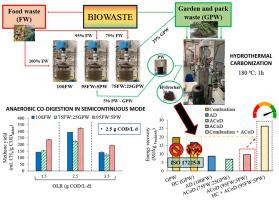当前位置:
X-MOL 学术
›
Waste Manag.
›
论文详情
Our official English website, www.x-mol.net, welcomes your feedback! (Note: you will need to create a separate account there.)
Biowaste management by hydrothermal carbonization and anaerobic co-digestion: Synergistic effects and comparative metagenomic analysis
Waste Management ( IF 8.1 ) Pub Date : 2024-03-16 , DOI: 10.1016/j.wasman.2024.03.019 E. Suárez , M. Tobajas , A.F. Mohedano , M.A. de la Rubia
Waste Management ( IF 8.1 ) Pub Date : 2024-03-16 , DOI: 10.1016/j.wasman.2024.03.019 E. Suárez , M. Tobajas , A.F. Mohedano , M.A. de la Rubia

|
The feasibility of anaerobic co-digestion in semicontinuous mode of two major urban biowaste, food waste (FW) and garden and park waste (GPW) (75 % FW and 25 % GPW) as well as the co-digestion of FW with the process water originated from the hydrothermal carbonization of GPW (95 % FW and 5 % process water), both on a COD basis, has been assessed. The effect of varying organic loading rate (OLR) from 1.5 to 3.5 g COD/L·d on methane yield, gross energy recovery, and microbiome population was evaluated. For comparison, anaerobic digestion of FW was also conducted to determine the best strategy for sustainable biowaste management. This study showed an optimal OLR of 2.5 g COD/L·d. Acetic and propionic acid content increased as OLR raised for each condition studied, while methane yield decreased at the highest OLR tested indicating overloading of the system. The anaerobic co-digestion of FW and process water showed a 10 % increase on methane production compared to anaerobic digestion of FW (324 vs 294 mL CH STP/L·d). Moreover, it enhances the process due to a greater abundance and diversity of hydrolytic and acidogenic bacteria belonging to Bacterioidota, Firmicutes, and Chloroflexi phyla, as well as promotes the hydrogenotrophic pathway under higher propionic concentrations which is not usually favoured for methane production. The integration of hydrothermal carbonization of GPW with the anaerobic co-digestion of 95 % FW and 5 % of process water results in the highest potential energy recovery and could be a good strategy for sustainable management of urban biowaste.
中文翻译:

通过水热碳化和厌氧共消化进行生物废物管理:协同效应和比较宏基因组分析
以半连续模式对两种主要城市生物垃圾——食物垃圾(FW)和花园和公园垃圾(GPW)(75% FW 和 25% GPW)进行厌氧共消化的可行性,以及 FW 与该工艺的共消化的可行性来自 GPW 热液碳化的水(95% FW 和 5% 工艺水)均以 COD 为基础进行了评估。评估了 1.5 至 3.5 g COD/L·d 之间不同的有机负荷率 (OLR) 对甲烷产量、总能量回收和微生物群落的影响。为了进行比较,还对 FW 进行了厌氧消化,以确定可持续生物废物管理的最佳策略。本研究显示最佳 OLR 为 2.5 g COD/L·d。对于每个研究条件,乙酸和丙酸含量随着 OLR 的升高而增加,而在测试的最高 OLR 下甲烷产量下降,表明系统过载。与 FW 厌氧消化相比,FW 和工艺水的厌氧共消化显示甲烷产量增加了 10%(324 vs 294 mL CH STP/L·d)。此外,由于属于拟杆菌门、厚壁菌门和绿柔菌门的水解和产酸细菌的丰度和多样性更大,它增强了这一过程,并在较高丙酸浓度下促进氢营养途径,而丙酸浓度通常不利于甲烷生产。将 GPW 水热碳化与 95% FW 和 5% 工艺水的厌氧共消化相结合,可实现最高的潜在能量回收,可能是城市生物废物可持续管理的良好策略。
更新日期:2024-03-16
中文翻译:

通过水热碳化和厌氧共消化进行生物废物管理:协同效应和比较宏基因组分析
以半连续模式对两种主要城市生物垃圾——食物垃圾(FW)和花园和公园垃圾(GPW)(75% FW 和 25% GPW)进行厌氧共消化的可行性,以及 FW 与该工艺的共消化的可行性来自 GPW 热液碳化的水(95% FW 和 5% 工艺水)均以 COD 为基础进行了评估。评估了 1.5 至 3.5 g COD/L·d 之间不同的有机负荷率 (OLR) 对甲烷产量、总能量回收和微生物群落的影响。为了进行比较,还对 FW 进行了厌氧消化,以确定可持续生物废物管理的最佳策略。本研究显示最佳 OLR 为 2.5 g COD/L·d。对于每个研究条件,乙酸和丙酸含量随着 OLR 的升高而增加,而在测试的最高 OLR 下甲烷产量下降,表明系统过载。与 FW 厌氧消化相比,FW 和工艺水的厌氧共消化显示甲烷产量增加了 10%(324 vs 294 mL CH STP/L·d)。此外,由于属于拟杆菌门、厚壁菌门和绿柔菌门的水解和产酸细菌的丰度和多样性更大,它增强了这一过程,并在较高丙酸浓度下促进氢营养途径,而丙酸浓度通常不利于甲烷生产。将 GPW 水热碳化与 95% FW 和 5% 工艺水的厌氧共消化相结合,可实现最高的潜在能量回收,可能是城市生物废物可持续管理的良好策略。



























 京公网安备 11010802027423号
京公网安备 11010802027423号